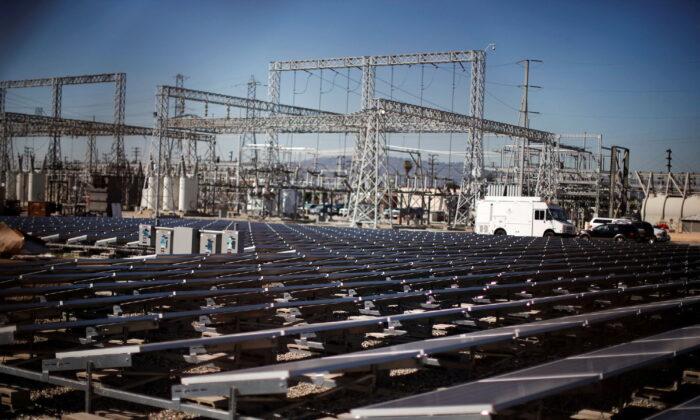Commentary
You might want to trade in your Tesla for a
2023 V8 Dodge Charger Hemi 870 horsepower gas guzzler. It turns out California will have practically no effect on reducing global temperatures no matter what you and other residents do—including how much carbon you use in your life of fun in the Golden State sun.
At a May 4
hearing of the Senate Appropriations Committee, Sen. John Kennedy (R-La.) quizzed David Turk, Deputy Secretary of the U.S. Department of Energy. Kennedy kept asking what the results would be on global temperatures if America went “carbon neutral” by 2050. Here’s a sample exchange, after Turk quoted some experts saying it would cost $50 trillion.
Kennedy: “If we spend $50 trillion to become carbon neutral by 2050 in the United States of America, how much is that going to reduce world temperatures?”
Turk: “So, every country around the world needs to get its act together. Our emissions are about 13 percent of global emissions right now.”
Kennedy: “Yeah, but if you could answer my question. If we spend $50 trillion to become carbon neutral in the U.S. by 2050, you’re the Deputy Secretary of Energy, give me your estimate of how much that is going to reduce world temperatures.”
Turk: “So, first of all, it’s a net cost. It’s what, um, benefits we’re having from getting our act together and reducing all of those costs and climate benefits.”
It went on like that longer. Turk never answered the question. The clear implication: There’s no indication becoming “carbon neutral” will have a significant effect on global temperatures. And what guarantees do we have that spending the $50 trillion will even get us to “carbon neutral” by 2050?
The GDP of the United States in 2023 is estimated to be about $26.5 trillion, or just over half that $50 trillion cost.
Also, California emissions were 303.4 million metric tons of carbon dioxide in 2020,
according to Choose Energy, out of 4,592 million metric tons for the entire United States. That’s 6.6 percent of the U.S. total.
So if U.S. emissions are 13 percent of global emissions, as Turk said, then California emissions are just 0.86 percent of the global total. (6.6 percent of 13 percent = 0.86 percent.) Less than 1 percent.
California Going ‘Carbon Neutral’
As you may recall, last November the California Air Resources Board released what it
headlined, “California Releases World’s First Plan to Achieve Net Zero Carbon Pollution” by 2045. It detailed:
“This updated plan follows Governor Gavin Newsom’s
push to move faster to achieve new, ambitious climate goals, setting new targets for renewable energy, clean buildings, carbon removal, and clean fuels in the transportation sector. If adopted by CARB, this plan will be a critical component of Governor Newsom’s
California Climate Commitment—a set of world-leading actions to build out a 100 percent clean energy grid, achieve carbon neutrality by 2045, ramp up carbon removal and sequestration, protect Californians from harmful oil drilling, and invest $54 billion to forge an oil-free future while building sustainable communities throughout the state.”
To do that, the state is
mandating 100 percent new zero-emission vehicles by 2035. So no Dodge Hemis. And it’s
banning new diesel trucks by 2036. And train engines older than 23 years will be
banned by 2030.
China ‘Carbon Neutral’?
Another country pledging to be “carbon neutral” is Communist China. In September 2020, Chinese leader Xi Jinping promised “carbon neutrality” by 2060. He
said, “China will scale up its intended nationally determined contributions [under the Paris climate agreement] by adopting more vigorous policies and measures.”
Well, it shouldn’t be surprising Xi isn’t exactly keeping his promise on that any more than on anything else. The Guardian just
reported:
“Local governments in
China approved more new coal power in the first three months of 2023 than in the whole of 2021, according to official documents.
“The approvals, analyzed by Greenpeace, reveal that between January and March this year, at least 20.45 gigawatts of coal power was approved, up from 8.63GW in the same period in 2022. In the whole of 2021, 18GW of coal was approved.”
I like to keep Epoch Times readers updated on the real state of what’s going on with coal power and other energy production around the world. And to compare it with the United States and California. (Such as on April 20, “Update:
World Not Following California on Decarbonization.”)
According to the Union of Concerned Scientists, in 2023 the United States is retiring 9.0 GW of coal production. That is, it’s cutting less than half the new 20.45 GW approved in just the first three months of this year by the PRC.
And California Local
reported last October:
“California, as of 2022, has just one functioning coal-fired power plant—
the Argus Cogen plant in San Bernardino County, which has a capacity of 63 megawatts of electricity. By contrast, the state’s last operating nuclear plant, Diablo Canyon in San Luis Obispo County, has a capacity of 2.26 gigawatts, about 36 times as much as the coal plant. ”
And 63 MW = .063 GW. So even if California got rid of all its meager coal production, that would amount to just 0.3 percent of the new production Communist China is approving every three months. (.063 is 0.3 percent of 20.45.)
Of course, other California “carbon” production comes from natural gas electricity production and carbon-powered vehicles. But the point is, California is not leading the world in “carbon neutrality.” It’s only leading its own citizens to flee the state’s expensive mandates, which have imposed the second-highest electricity costs in the country,
according to the U.S. Energy Information Administration.
For us it’s 19.65 cents per kilowatt hour, below only Hawaii’s 30.31 cents. By comparison, neighboring Nevada is 8.58, Arizona is 10.73, and Oregon is 8.95. For major rival states, Florida is 10.67 and Texas is 9.14. Notice they’re all about the same.
So if you move to the Sunshine State or the Lone Star State, you not only don’t have to pay California’s confiscatory income tax, your electricity rates will be cut in half. Albeit you might have to run the air conditioning longer in the muggy weather. And they have a lot more bugs. So you’ll have to buy one of those electric bug zappers.
California’s “carbon neutrality” mandates are a chimera. They only damage residents and push many of them out.
Views expressed in this article are opinions of the author and do not necessarily reflect the views of The Epoch Times.





